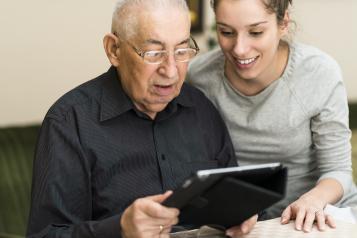What is a virtual ward?

What is a virtual ward?
A virtual ward, also known as hospital at home, is a safe, efficient alternative to NHS in-hospital care. It allows patients to receive hospital-level care in the comfort of their own homes. Patients can also be treated on virtual wards if they reside in a hospice or care home.
Treating patients in surroundings familiar to them, with the support of friends or family or other care support nearby, can speed up their recovery. It also frees up beds for those patients who require in-hospital care.
What can be treated on a virtual ward?
Virtual wards can monitor a range of conditions, including but not limited to:
- Osteoporosis, Frailty & Falls Recovery Treatment
- Wound Care & Pressure Injury Management
- Respiratory Illnesses & Infections
- Urinary Tract Infections (UTIs)
- Diabetes
- Oncology
- Mental health
- Learning disabilities
Virtual wards are also set to expand to treat people experiencing heart conditions or heart failure.
How can NHS@home Virtual Wards help?
Support through the Bath and North East Somerset, Swindon and Wiltshire (BSW) NHS@Home Virtual Wards service can sometimes include using monitoring technology via applications on a mobile phone and/or wearable technology. Patients will be given support on how to use any devices, and how staff will get in touch.
The team will schedule regular visits to deliver treatment and care. Patients will also have access to advice and support outside of these visits.
Through regular monitoring, the team will be able to spot any signs of someone becoming more unwell. If this happens, the team will make sure the patient can access hospital care quickly.
Top tips for patients
- Ask for a time slot for when your remote consultation will take place.
- Let your health care provider know how you prefer to talk by phone, video or in-person.
- Find somewhere quiet and confidential and, if this isn’t possible or is tricky, make this clear when you are making your appointment.
- Start with a phone call if you’re not confident with video technology.
- Ask for help if you need it and, if possible, do a practice run with a friend.
- Take some time to prepare in advance, consider what you want to say and key questions you would like to ask.
- Ask your health care provider to summarise the next steps at the end of the appointment.
- Remote consultations can be useful for routine appointments or ongoing care with a health care practitioner.
- Not all appointments are suitable for remote consultations, if you would like to see someone in-person please say so.
Top tips for healthcare professionals
- Provide a precise time window for appointments.
- Check that the person is in a confidential and safe place to have the phone or video call.
- Understand the person’s level of confidence using technology and give people a choice of how to communicate.
- Proactively check what the patient needs, clarify what is happening next and who is responsible for the next stages of care.
- Slow down the pace of the consultation, demonstrate active listening.
- Use the chat function in video calls to make the appointment more interactive, share links to information or summarise next steps.
- Don’t ask people to provide information you already have access to.
- Give guidance about how the appointment will work, offer demonstrations, provide an opportunity for a test run/provide some training.
- Seek feedback about peoples’ experiences and use this to improve the service.


